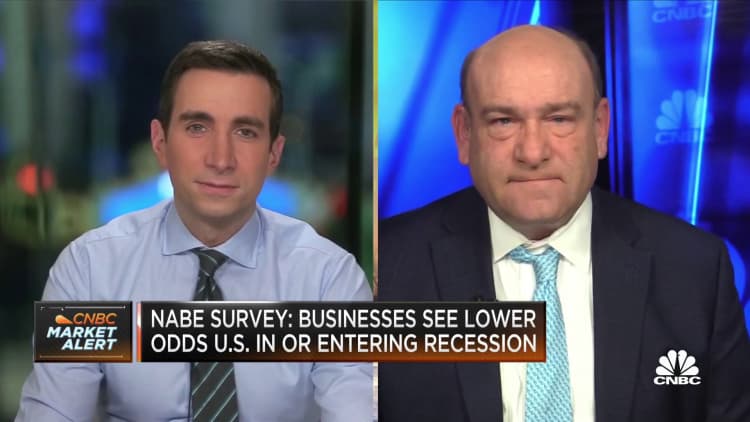Westend61 | Westend61 | Getty Images
Experts have been pointing to a coming downturn for the U.S. economy. The question was when.
Now, however, some firms and experts are walking back those predictions, calling into question the validity of a once-trusted recession indicator known as the yield curve inversion.
“While it is true that the yield curve has predicted the past several recessions, in more recent experience it’s been sort of a broken odometer for the economy,” said Mervin Jebaraj, economic policy survey chair at the National Association for Business Economics.
In its latest survey of economists, NABE found more than two-thirds of respondents were at least somewhat confident the Federal Reserve can help the U.S. economy to a soft landing. Meanwhile, 20% believe the U.S. is either in a recession or will enter one this year.
Wall Street firms have also been signaling increased optimism that a recession — typically defined as two consecutive quarters of declines in gross domestic product — may be avoided.
Goldman Sachs now predicts a 15% chance of a recession, down from 20%. Others, including Bank of America and JPMorgan, have also recently backed off stronger recession calls.
The U.S. would have already fallen into a recession if not for a strong job market, according to NABE’s survey.
Yet the NABE results also showed economists are divided as to what a key recession indicator — the yield curve inversion — reveals about the direction of the U.S. economy.
The yield curve is a graph showing the relationship between yields on fixed income securities versus the length of time they have to maturity.
When the yield curve for U.S. Treasurys slopes upward, with long-term Treasurys providing higher yields, it is said to be normal, according to NABE’s Jebaraj, who also serves as director of the Center for Business and Economic Research at the Sam M. Walton College of Business at the University of Arkansas.
“The thinking generally is that the longer someone holds the Treasury, you should offer them higher interest rates, because they’re giving up their money for a longer period of time,” Jebaraj said.
However, when investors think short-term economic prospects are worse than long-term prospects, that prompts higher yields on short-term Treasurys, and a downward-sloping yield curve. The inverted yield curve is often thought to be a recession predictor.
Nobody rational would argue that the yield curve could have predicted a global pandemic and the short recession that followed it.
Mervin Jebaraj
economic policy survey chair at the National Association for Business Economics
This week, Treasury yields have risen as investors weigh new economic data, including an unemployment rate increase to 3.8%. The yield on the 2-year Treasury climbed to 4.935% versus the 10-year Treasury, which rose to 4.252%.
NABE’s most recent survey shows economists are divided on what a yield curve inversion means for the U.S. economy.
The most popular conclusion — at 38% — was that it points to declining inflation without a recession. But almost as many respondents — 36% — said they believe it indicates a recession in the next 12 to 18 months. Another 14% see low long-term bond premiums and no recession.
In normal circumstances, yield curve inversions have been a pretty good indicator of recessions, according to Jebaraj.
But that has not always been the case. While the yield curve inverted in 2019, that was not necessarily a predictor of the 2020 recession.
“Nobody rational would argue that the yield curve could have predicted a global pandemic and the short recession that followed it,” Jebaraj said.

Current recession predictions are largely based on what has happened in the past, he said. Whenever the Fed has raised interest rates aggressively, that has prompted a recession.
Other experts are also waiting to see what the indicator portends for the U.S. economy.
Each time an inverted yield curve lasts longer, analysts typically say, “Well, this time it’s different,” noted Barry Glassman, a certified financial planner and founder and president of Glassman Wealth Services.
“Maybe this time it is different,” said Glassman, who is also a member of the CNBC FA Council.
“But there are reasons why it’s usually a predictor that a recession is coming in the near-to-intermediate term,” he said.
Recession or not, experts’ advice to prepare for a downturn still holds true — where possible, set aside emergency cash to weather an unforeseen event or job loss.

